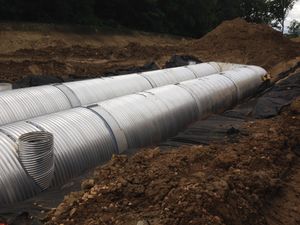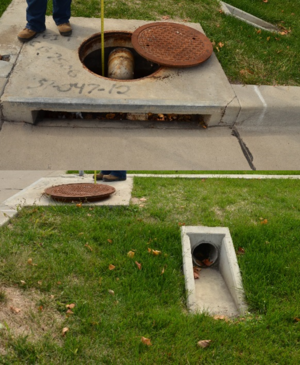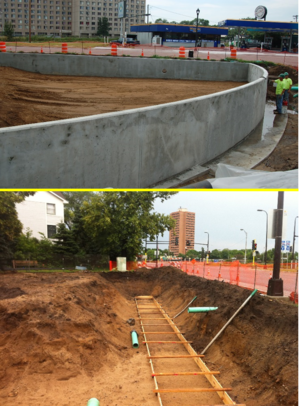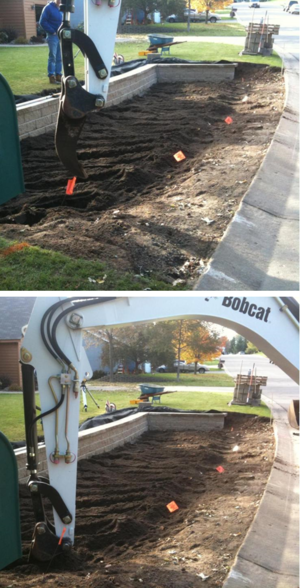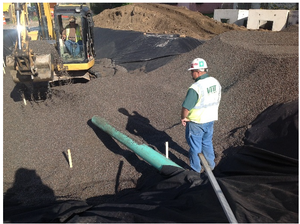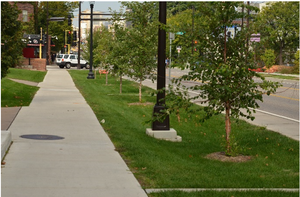
Difference between revisions of "Construction specifications for infiltration"
m |
m (→Useful links) |
||
| (19 intermediate revisions by 2 users not shown) | |||
| Line 1: | Line 1: | ||
| − | {{alert| | + | [[File:Technical information page image.png|100px|left|alt=image]] |
| + | {{alert|Infiltration practices can be an important tool for retention and detention of stormwater runoff and treatment of pollutants in stormwater runoff. If the practice utilizes vegetation, additional benefits may include cleaner air, carbon sequestration, improved biological habitat, and aesthetic value.|alert-success}} | ||
This page provides a discussion of construction specifications for infiltration basins, trenches, and underground infiltration, including a construction sequence. | This page provides a discussion of construction specifications for infiltration basins, trenches, and underground infiltration, including a construction sequence. | ||
| Line 7: | Line 8: | ||
==Construction specifications for infiltration practices== | ==Construction specifications for infiltration practices== | ||
| + | [[file:Underground infiltration 1.JPG|300px|thumb|alt=photo underground pipes|<font size=3>Installation of underground infiltration pipes.</font size>]] | ||
| + | |||
Construction of infiltration practices incorporates techniques and steps that may be considered nonstandard. It is recommended that construction specifications include project pretreatment devices, construction sequencing, temporary and permanent erosion control measures, excavation and fill, grading, soil decompaction, material specifications, and final stabilization. All of these topics are addressed in further detail below. | Construction of infiltration practices incorporates techniques and steps that may be considered nonstandard. It is recommended that construction specifications include project pretreatment devices, construction sequencing, temporary and permanent erosion control measures, excavation and fill, grading, soil decompaction, material specifications, and final stabilization. All of these topics are addressed in further detail below. | ||
| − | Additional specifications for items applicable to infiltration practices can be found in the [http://www.dot.state.mn.us/pre-letting/spec/ Minnesota Department of Transportation’s (MnDOT) Specifications for Construction] | + | Additional specifications for items applicable to infiltration practices can be found in the [http://www.dot.state.mn.us/pre-letting/spec/ Minnesota Department of Transportation’s (MnDOT) Specifications for Construction]. Below is a list of MnDOT sections that may be helpful when writing project specifications for infiltration practices. |
:1717 Air, land and water pollution | :1717 Air, land and water pollution | ||
:2101 Clearing and grubbing | :2101 Clearing and grubbing | ||
| Line 50: | Line 53: | ||
===Inspection and documentation=== | ===Inspection and documentation=== | ||
| − | Inspections before, during, and after construction are needed to ensure infiltration practices are built in accordance with the plans and specifications. It is recommended that onsite inspectors are familiar with project plans and specifications to ensure the contractor’s interpretation of the plans are consistent with the designer’s intent. The inspectors should take frequent photos and notes of construction activities and features as work progresses and at all critical points (such as immediately prior to backfilling). They should check dimensions and depths of all installed materials. All materials and products should be verified or tested for conformance with the specifications | + | Inspections before, during, and after construction are needed to ensure infiltration practices are built in accordance with the plans and specifications. It is recommended that onsite inspectors are familiar with project plans and specifications to ensure the contractor’s interpretation of the plans are consistent with the designer’s intent. The inspectors should take frequent photos and notes of construction activities and features as work progresses and at all critical points (such as immediately prior to backfilling). They should check dimensions and depths of all installed materials. All materials and products should be verified or tested for conformance with the specifications. |
| + | |||
| + | :'''Construction checklists''' | ||
| + | *[http://stormwater.pca.state.mn.us/index.php/Infiltration_Trench_-_Construction_inspection_checklist Infiltration trench] | ||
| + | *[http://stormwater.pca.state.mn.us/index.php/Infiltration_basin_-_system_construction_inspection_checklist Infiltration basin] | ||
==Construction sequence== | ==Construction sequence== | ||
| Line 101: | Line 108: | ||
All seed and plants should be shipped and stored with protection from weather or other conditions that would damage the product. All plants and seeds will be inspected by the designer and items that have become wet, moldy, or otherwise damaged in transit or in storage should be rejected. Plants and seed should arrive within 24 hours of delivery. Plants and seed needs to be protected against drying and damage prior to planting. | All seed and plants should be shipped and stored with protection from weather or other conditions that would damage the product. All plants and seeds will be inspected by the designer and items that have become wet, moldy, or otherwise damaged in transit or in storage should be rejected. Plants and seed should arrive within 24 hours of delivery. Plants and seed needs to be protected against drying and damage prior to planting. | ||
| − | It is typical for the plant or seeding contractor to guarantee the work for some length of time. The common minimum for herbaceous plantings or sod is 60 days during the growing season. The growing season in central Minnesota is defined as May 1st through October 31st. A one-year guarantee on containerized plants can help to ensure good establishment and decrease weed infestations while maintaining infiltration rates over time through the growth of healthy root systems. Any watering required to keep the plants healthy should be covered under the cost of the warranty period. It is appropriate to require that the contractor provide some form of surety, such as a letter of credit or other security, to the permitting entity for 150 percent of the estimated costs and quantities of all herbaceous plants or seeding for the duration of the 1-year warranty period. Planting and seeding establishment should meet the requirements within [http://www.dot.state.mn.us/pre-letting/spec/ | + | It is typical for the plant or seeding contractor to guarantee the work for some length of time. The common minimum for herbaceous plantings or sod is 60 days during the growing season. The growing season in central Minnesota is defined as May 1st through October 31st. A one-year guarantee on containerized plants can help to ensure good establishment and decrease weed infestations while maintaining infiltration rates over time through the growth of healthy root systems. Any watering required to keep the plants healthy should be covered under the cost of the warranty period. It is appropriate to require that the contractor provide some form of surety, such as a letter of credit or other security, to the permitting entity for 150 percent of the estimated costs and quantities of all herbaceous plants or seeding for the duration of the 1-year warranty period. Planting and seeding establishment should meet the requirements within [http://www.dot.state.mn.us/pre-letting/spec/ Minnesota Department of Transportation’s (MnDOT) MnDOT Section 2571] (page 478). |
{{alert|Seeding maintenance requires specialized knowledge and experience in plant and weed identification. Ensure a thorough [http://stormwater.pca.state.mn.us/index.php/Operation_and_maintenance_of_stormwater_infiltration_practices maintenance plan] is established prior to construction and that budget has been allocated for at least three full growing seasons and preferable longer. Native seedings can be more difficult than containerized plantings to establish.|alert-danger}} | {{alert|Seeding maintenance requires specialized knowledge and experience in plant and weed identification. Ensure a thorough [http://stormwater.pca.state.mn.us/index.php/Operation_and_maintenance_of_stormwater_infiltration_practices maintenance plan] is established prior to construction and that budget has been allocated for at least three full growing seasons and preferable longer. Native seedings can be more difficult than containerized plantings to establish.|alert-danger}} | ||
| Line 110: | Line 117: | ||
As defined in the NPDES/SDS Construction Stormwater permit, final site stabilization is achieved when all soil disturbing activity is completed and the exposed soils have been stabilized with a vegetative cover with a uniform density of at least 70 percent over the entire site or by equivalent means to prevent soil failure. Simply seeding and mulching is not considered acceptable cover for final stabilization. Final stabilization must consist of an established permanent cover, such as a perennial vegetative cover, concrete, riprap, gravel, rooftops, asphalt, etc | As defined in the NPDES/SDS Construction Stormwater permit, final site stabilization is achieved when all soil disturbing activity is completed and the exposed soils have been stabilized with a vegetative cover with a uniform density of at least 70 percent over the entire site or by equivalent means to prevent soil failure. Simply seeding and mulching is not considered acceptable cover for final stabilization. Final stabilization must consist of an established permanent cover, such as a perennial vegetative cover, concrete, riprap, gravel, rooftops, asphalt, etc | ||
| − | + | The NPDES permit requires all stormwater treatment systems to meet all permit requirements and be operating as designed prior to submitting the NPDES notice of termination. This can be accomplished by [http://stormwater.pca.state.mn.us/index.php/Determining_soil_infiltration_rates infiltration rate testing] or by observation that all water in the stormwater practice draws down in 48 hours or less. It is highly recommended that all infiltration areas are tested prior to project close out, even if an NPDES permit is not required. | |
MnDOT projects requires at least five tests per acre of infiltration area and a minimum of five tests per infiltration area. Infiltration rates shall meet or exceed double the design rate assumed. The test results from a MnDOT project must be submitted to MnDOT. | MnDOT projects requires at least five tests per acre of infiltration area and a minimum of five tests per infiltration area. Infiltration rates shall meet or exceed double the design rate assumed. The test results from a MnDOT project must be submitted to MnDOT. | ||
| Line 117: | Line 124: | ||
Additional information on construction of infiltration practices can be found on the [http://stormwater.pca.state.mn.us/index.php/Construction_specifications_for_permeable_pavement Construction Specifications for Permeable Pavement] page. | Additional information on construction of infiltration practices can be found on the [http://stormwater.pca.state.mn.us/index.php/Construction_specifications_for_permeable_pavement Construction Specifications for Permeable Pavement] page. | ||
| + | |||
| + | ==Minnesota Department of Transportation example construction protocols== | ||
| + | |||
| + | {{:Minnesota Department of Transportation example construction protocols}} | ||
==CADD images== | ==CADD images== | ||
| Line 124: | Line 135: | ||
*subsurface infiltration system | *subsurface infiltration system | ||
*inlet/outlet structures | *inlet/outlet structures | ||
| + | |||
| + | ==Useful links== | ||
| + | *[https://chesapeakestormwater.net/wp-content/uploads/2022/07/3768-7.pdf Chesapeake Stormwater Network] TECHNICAL BULLETIN No. 10. Bioretention Illustrated: A Visual Guide for Constructing, Inspecting, Maintaining and Verifying the Bioretention Practice | ||
<noinclude> | <noinclude> | ||
==Related pages== | ==Related pages== | ||
| + | *[http://stormwater.pca.state.mn.us/index.php/Infiltration Infiltration portal] | ||
| + | |||
*[[Overview for infiltration]] | *[[Overview for infiltration]] | ||
*[[BMPs for stormwater infiltration|Types of infiltration]] | *[[BMPs for stormwater infiltration|Types of infiltration]] | ||
*[[Design criteria for infiltration]] | *[[Design criteria for infiltration]] | ||
*[[Construction specifications for infiltration]] | *[[Construction specifications for infiltration]] | ||
| − | *[[Operation and maintenance of infiltration]] | + | *[[Operation and maintenance of stormwater infiltration practices]] |
*[[Assessing the performance of infiltration]] | *[[Assessing the performance of infiltration]] | ||
*[[Calculating credits for infiltration]] | *[[Calculating credits for infiltration]] | ||
| Line 140: | Line 156: | ||
*[[References for infiltration]] | *[[References for infiltration]] | ||
*[[Requirements, recommendations and information for using infiltration basin/underground infiltration BMPs in the MIDS calculator]] | *[[Requirements, recommendations and information for using infiltration basin/underground infiltration BMPs in the MIDS calculator]] | ||
| + | |||
| + | *[[Understanding and interpreting soils and soil boring reports for infiltration BMPs]] | ||
| + | *[[Determining soil infiltration rates]] | ||
| + | *Cold climate considerations for infiltration practices - See [http://stormwater.pca.state.mn.us/index.php/Cold_climate_impact_on_runoff_management#Infiltration], [http://stormwater.pca.state.mn.us/index.php/Cold_climate_impact_on_runoff_management#Infiltration_practices] | ||
| + | |||
| + | [[Category:Level 3 - Best management practices/Specifications and details/Construction specifications]] | ||
</noinclude> | </noinclude> | ||
Latest revision as of 20:49, 27 December 2022
This page provides a discussion of construction specifications for infiltration basins, trenches, and underground infiltration, including a construction sequence.
Contents
Access agreements
An easement is a legally binding agreement between two parties, and is defined as ”a non-possessory right to use and/or enter onto the real property of another without possessing it.“ An easement is required for one party to access, construct, or maintain any feature or infrastructure on the property of another. Easements can be temporary or permanent. For example, temporary easements can be used if limits needed for construction are larger than the permanent easement footprint of constructed features. Having an easement provides a mechanism for enforcement of maintenance agreements to help ensure infiltration practices are maintained and functioning. See an example access agreement.
Construction specifications for infiltration practices
Construction of infiltration practices incorporates techniques and steps that may be considered nonstandard. It is recommended that construction specifications include project pretreatment devices, construction sequencing, temporary and permanent erosion control measures, excavation and fill, grading, soil decompaction, material specifications, and final stabilization. All of these topics are addressed in further detail below.
Additional specifications for items applicable to infiltration practices can be found in the Minnesota Department of Transportation’s (MnDOT) Specifications for Construction. Below is a list of MnDOT sections that may be helpful when writing project specifications for infiltration practices.
- 1717 Air, land and water pollution
- 2101 Clearing and grubbing
- 2105 Excavation and embankment
- 2511 Riprap
- 2571 Plant installation and establishment
- 2572 Protection and restoration of vegetation
- 2573 Storm water management
- 2574 Soil preparation
- 2575 Establishing turf and controlling erosion
- 3149 Granular material
- 3877 Topsoil material
- 3878 Sod
- 3882 Mulch material
- 3884 Hydraulic erosion control products
- 3885 Rolled erosion control products
- 3897 Sediment control log
Pre-construction meeting
A pre-construction meeting is recommended and should include a walkthrough of the site with the builder/contractor/subcontractor to identify important features of the work and to review and discuss the plans. This is the best time to identify potential issues related to construction methods and sequencing that will affect site protection, erosion and sediment control, and proper installation of the work.
Site protection
Pretreatment
Pretreatment is a required part of infiltration and filtration practices. Pretreatment is needed to protect BMPs from the build-up of trash, gross solids, and particulate matter. When the velocity of stormwater decreases, sediment and solids drop out. If pretreatment is not provided, this process will occur in the BMP, resulting in long-term clogging and poor aesthetics.
Temporary erosion and sediment control
During construction, it is critical to keep sediment out of the infiltration device as much as practicable. Utilizing sediment and erosion control measures will help to keep infiltration areas from clogging. As soon as grading is complete, stabilize slopes to reduce erosion of native soils. Protect temporary soil stockpiles from run-on and run-off from adjacent areas and from erosion by wind. Sweep as often as required if sediment is on paved surfaces to prevent transport offsite by tracking and airborne dust. All sediment and erosion control measures must be properly installed and maintained. When sediment build up reaches 1/3 the height of the device, action is required, such as removing the accumulated sediment or installing additional sediment controls downgradient of the original device. Link here for more information.
- It is REQUIRED that future infiltration locations not be used as temporary sedimentation basins unless 3 feet of cover is left in place during construction.
- If the infiltration area is excavated to final grade (or within 3 feet of) it is REQUIRED that rigorous erosion prevention and sediment controls (e.g., diversion berms) are used to keep sediment and runoff infiltration away from the infiltration area.
Compaction prevention
Preventing and alleviating compaction are crucial during construction of infiltration practices, as compaction can reduce infiltration rates by increasing bulk density of the soil. The infiltration area should be marked with paint and/or stakes to keep construction traffic from traveling in the area.
Inspection and documentation
Inspections before, during, and after construction are needed to ensure infiltration practices are built in accordance with the plans and specifications. It is recommended that onsite inspectors are familiar with project plans and specifications to ensure the contractor’s interpretation of the plans are consistent with the designer’s intent. The inspectors should take frequent photos and notes of construction activities and features as work progresses and at all critical points (such as immediately prior to backfilling). They should check dimensions and depths of all installed materials. All materials and products should be verified or tested for conformance with the specifications.
- Construction checklists
Construction sequence
Step 1 – Site examination and preparation
It is the responsibility of the contractor to:
- Examine the areas for performing earthwork and determine that conditions are satisfactory to proceed, or to correct all unsatisfactory conditions prior to starting work.
- Arrange to locate, mark, and protect all existing utilities and underground facilities in the areas of work.
- Remove all existing features marked for removal and required earthwork
Step 2 – Excavation
Sub-cut the infiltration area as shown on the plans. Where possible, excavation should be performed with a backhoe and work should be done from the sides and outside the footprint of the infiltration area to avoid soil compaction. If it is necessary to work in the infiltration area, only low ground pressure tracked equipment should be allowed to complete the work. Rubber tire equipment should be strictly prohibited within the infiltration area, unless working from pavement outside of the basin or trench. The contractor should start the work at the far side of the trench or basin and work their way out.
Contractor is to ensure all laws and regulations are followed regarding stability of excavations. This may require shoring, bracing, sloping, or benching. Materials should not be stockpiled near the edge of the excavation. Drainage and control of water in the excavation must also be considered.
Step 3 – Decompaction
Subsoil decompaction is required in all infiltration areas. Decompact subsoil with a backhoe ripper attachment or other approved method to a depth of at least 18 inches below subgrade in all locations indicated on the drawings. Also known as soil loosening or soil ripping, this technique has been shown to increase infiltration and reduce compaction from construction activities. For more information on alleviating compaction, link here.
Step 4 – Subsoil Infiltration Testing
Subsoil infiltration testing is recommended prior to the placement of any infiltration media. After the subsoil is decompacted, test the infiltration area to verify the assumed infiltration rate and that the infiltration area will drain dry within 48 hours. This can be accomplished by performing double ring infiltrometer tests (ASTM D3385) in the bottom of the basin, or by filling the infiltration basin and timing how long it takes to drain from maximum water depth to dry bottom. The measured infiltration rate should equate to double the designed infiltration rate. If the basin is filled with water to perform this check, be sure sediments are not being washed into the basin during filling. If sediments are washed into the basin, they need to be removed prior to placing infiltration media.
If the basin does not drain dry within 48 hours, 24 hours for special waters, or the infiltration rate is slower than twice what was assumed in the design, additional soil loosening or modification may be necessary.
Information on soil testing can be found here.
Step 5 – Installation of materials - infiltration media
Soil test results should be provided to the designer a minimum of two weeks prior to delivery of planting soil to the site. Submitted test results should include gradation and USDA soil texture classification or certification that the soil mix meets MnDOT specifications or other requirements. Samples of the mixed product should be also provided to the designer two weeks prior to delivery of media to the site. The designer should review the materials as soon as possible to avoid any potential delays in the procurement and review of another media source should the initial submittal not meet specifications.
All accumulated sediment and silt from the bottom of the infiltration area should be removed prior to the placement of infiltration media. The contractor should make every effort possible to place the infiltration media in a way to minimize compaction of the subgrade and the infiltration media itself. No construction vehicles are allowed in the infiltration area after the media is placed unless approved by designer. Decompaction should occur if the subgrade has been compacted by construction equipment or supplies. Loose placement of infiltration media shall be accomplished by dumping from the edges and spreading with the bucket of a backhoe, which is outside of the infiltration area, or some other acceptable means determined by the designer. If spreading with a backhoe is not possible for the entire area of the infiltration area, only tracked skid steers or other low ground pressure equipment should be permitted in the basin to spread the infiltration media. This method should be minimized as much as possible. Travel over placed infiltration media should be strictly prohibited. The contractor should overfill the infiltration media areas approximately 20 percent to account for consolidation of the loose soil once wetting occurs. Any small irregularities at the designed finished grade should be worked out with hand tools. The contractor should contact the designer upon final placement of media for a final inspection prior to planting and mulching. At this inspection, the designer should check thickness and grades after soil wetting occurs and notify the contractor of areas that do not meet the tolerances specified. Tolerances in final grade are commonly vertically +/- 0.1 foot and horizontally +/- 0.5 foot.
If time goes by between the initial placement of infiltration media and planting, the contractor should be required to remove or mix in accumulated silt. This work is also a chance to perform any final subgrade grading adjustments required to obtain the finished grades as shown on the drawing.
Step 6 – Restoration and plantings
After final placement of infiltration media has been approved, planting or seeding should happen as soon as possible to avoid erosion, sedimentation, and the establishment of weeds. The contractor should notify the designer at least four days in advance of when planting or seeding will occur in advance of delivery of materials to the site to allow for scheduling of site inspections. At least two weeks prior to the planting or seeding dates, any existing weeds should be thoroughly eradicated mechanically or with herbicide within the project area.
All seed and plants should be shipped and stored with protection from weather or other conditions that would damage the product. All plants and seeds will be inspected by the designer and items that have become wet, moldy, or otherwise damaged in transit or in storage should be rejected. Plants and seed should arrive within 24 hours of delivery. Plants and seed needs to be protected against drying and damage prior to planting.
It is typical for the plant or seeding contractor to guarantee the work for some length of time. The common minimum for herbaceous plantings or sod is 60 days during the growing season. The growing season in central Minnesota is defined as May 1st through October 31st. A one-year guarantee on containerized plants can help to ensure good establishment and decrease weed infestations while maintaining infiltration rates over time through the growth of healthy root systems. Any watering required to keep the plants healthy should be covered under the cost of the warranty period. It is appropriate to require that the contractor provide some form of surety, such as a letter of credit or other security, to the permitting entity for 150 percent of the estimated costs and quantities of all herbaceous plants or seeding for the duration of the 1-year warranty period. Planting and seeding establishment should meet the requirements within Minnesota Department of Transportation’s (MnDOT) MnDOT Section 2571 (page 478).
Applying mulch is an important tool for preventing weed establishment and retaining moisture for the plants or seed. Twice-shredded hardwood mulch is readily available and appropriate for use in plantings that use contained plant stock. Straw or native grass cuttings are very effective on sites that have been seeded.
Step 7 – Final stabilization and Closeout
As defined in the NPDES/SDS Construction Stormwater permit, final site stabilization is achieved when all soil disturbing activity is completed and the exposed soils have been stabilized with a vegetative cover with a uniform density of at least 70 percent over the entire site or by equivalent means to prevent soil failure. Simply seeding and mulching is not considered acceptable cover for final stabilization. Final stabilization must consist of an established permanent cover, such as a perennial vegetative cover, concrete, riprap, gravel, rooftops, asphalt, etc
The NPDES permit requires all stormwater treatment systems to meet all permit requirements and be operating as designed prior to submitting the NPDES notice of termination. This can be accomplished by infiltration rate testing or by observation that all water in the stormwater practice draws down in 48 hours or less. It is highly recommended that all infiltration areas are tested prior to project close out, even if an NPDES permit is not required.
MnDOT projects requires at least five tests per acre of infiltration area and a minimum of five tests per infiltration area. Infiltration rates shall meet or exceed double the design rate assumed. The test results from a MnDOT project must be submitted to MnDOT.
When a final construction inspection has been completed, log the GPS coordinates for each facility and submit them for entry into the local BMP maintenance tracking database, if available.
Additional information on construction of infiltration practices can be found on the Construction Specifications for Permeable Pavement page.
Minnesota Department of Transportation example construction protocols
Preliminary analysis and selection
Recommended number of soil borings, pits or permeameter tests for bioretention design. Designers select one of these methods.
Link to this table
| Surface area of stormwater control measure (BMP)(ft2) | Borings | Pits | Permeameter tests |
|---|---|---|---|
| < 1000 | 1 | 1 | 5 |
| 1000 to 5000 | 2 | 2 | 10 |
| 5000 to 10000 | 3 | 3 | 15 |
| >10000 | 41 | 41 | 202 |
1an additional soil boring or pit should be completed for each additional 2,500 ft2 above 12,500 ft2
2an additional five permeameter tests should be completed for each additional 5,000 ft2 above 15,000 ft2
Field verification testing prior to pond construction
- Soil hydraulic group represent what is stated in SWPPP (Stormwater Pollution Prevention Plan)
- Seasonally high water table not discovered within 3 feet of the excavated pond base within a test pit
- Commonly will test bottom of proposed pond for soil compaction (subsequent subsoil ripping) prior to media placement
- Commonly will test bottom of proposed pond for insitu infiltration rate by test pit or water filled barrel placed on pond base surface
Filter media and material testing
- Existing soil (option 1 below) or Washed sand (option 2 below), and compost certification
- Washed course aggregate choker certification
- Other treatment material certification of iron filings, activated charcoal, pH buffers, minerals, etc.
- Geotextile separation fabric certification
- Drain-tile certification (if filtration is specified)
- Seed source certification
- Barrel test verification of infiltration rate using 2.5 feet of imported 3877 Type G media
Field verification testing/inspection/verification during construction
- Water drains away in 48 hours
- Infiltration drainage rate does not exceed 8.3 inches per hour
- No tracking/equipment in pond bottom
- No sediment deposits from ongoing construction activity, media perimeter controls kept functional
- Forebay is trapping settleable solids, floating materials, and oil/grease
- Area staked off
Notice of Termination (NOT) verification
- Option 1. Amending existing HSG soils with compost or other treatment material. Test the infiltration rate of each infiltration basin using a double ring infiltrometer prior to completion of the basin. Conduct the test at the finished grade of the basin bottom, prior to blending the compost with the in-situ soils or sand. Ensure infiltration rates meet or exceed greater of two times the designed infiltration rate or 2 inches per hour. Conduct a minimum of five tests per representative acre of basin area and a minimum of five tests per basin. Conduct double ring infiltrometer tests in accordance with ASTM standards. Thoroughly wet test areas prior to conducting infiltrometer tests.
- Option 2. Importing 3877 Type G Filter Topsoil Borrow (may be amended with other treatment material). Ensure infiltration rates meet or exceed greater of two times the designed infiltration rate or 2 inches per hour, or rate specified in the plan. Conduct a minimum of five tests per representative acre of basin area and a minimum of five tests per basin. Conduct double ring infiltrometer tests in accordance with ASTM standards. Thoroughly wet test areas prior to conducting infiltrometer tests. Amend soils with additional washed sand if rates less than specified in the contract, or compost if rates exceed 8.3 inches per hour.
The permanent stormwater management system must meet all requirements in sections 15, 16, and 17 of the CSW permit and must operate as designed. Temporary or permanent sedimentation basins that are to be used as permanent water quality management basins have been cleaned of any accumulated sediment. All sediment has been removed from conveyance systems and ditches are stabilized with permanent cover.
CADD images
CADD based details for pond systems are contained in the section on drawings. The following details, with specifications, have been created for infiltration systems:
- infiltration basin
- infiltration trench
- subsurface infiltration system
- inlet/outlet structures
Useful links
- Chesapeake Stormwater Network TECHNICAL BULLETIN No. 10. Bioretention Illustrated: A Visual Guide for Constructing, Inspecting, Maintaining and Verifying the Bioretention Practice
Related pages
- Overview for infiltration
- Types of infiltration
- Design criteria for infiltration
- Construction specifications for infiltration
- Operation and maintenance of stormwater infiltration practices
- Assessing the performance of infiltration
- Calculating credits for infiltration
- Cost-benefit considerations for infiltration
- Case studies for infiltration
- External resources for infiltration
- References for infiltration
- Requirements, recommendations and information for using infiltration basin/underground infiltration BMPs in the MIDS calculator
- Understanding and interpreting soils and soil boring reports for infiltration BMPs
- Determining soil infiltration rates
- Cold climate considerations for infiltration practices - See [1], [2]
This page was last edited on 27 December 2022, at 20:49.

